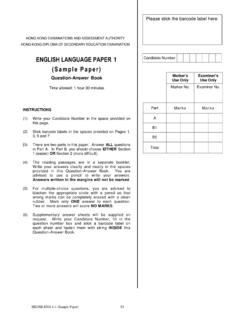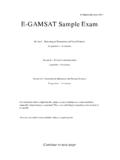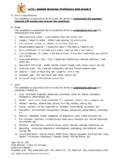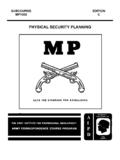Transcription of GCSE Physical Education Movement analysis (planes and axes ...
1 Lesson plan: Movement analysis (planes and axes) This sample lesson plan helps teachers to structure a one hour lesson on planes and axes , as part of the Movement analysis topic on paper 1 for GCSE Physical Education (week 20, year 1 scheme of work, 2 year plan). It is suggested as a guide only and can be amended to suit teachers and their students needs. Learning objectives Develop knowledge and understanding of the various planes and axes. Develop knowledge and understanding of how to analyse Movement in sport along a plane and around an axis. Learning outcomes All students should be able to name the three planes of Movement and the three axes of rotation. All students should be aware of sporting movements that take place along a plane. All students should be aware of sporting movements that take place around an axis. Most students will be able to distinguish between specific sporting skills along planes and around axes. Some students will be able to select sporting skills of their choice which move along a stated plane and around a stated axis.
2 Prior knowledge needed This is a very discrete topical area that requires no specific knowledge in advance of the lesson. Students will need to be able to interpret how sporting skills are carried out to understand which plane and axis is relevant. Lesson preparation Preparation for this lesson is minimal. Teachers should have handout 1 ready for reference and handout 2 for use during the lesson. Additionally, teachers may wish to source still images of sporting skills being performed and/or visual clips from YouTube (or equivalent video sharing website). Teachers should purchase some play dough and wooden skewers prior to the lesson. Activity Duration Activity Group size Assessment objective 10 minutes Ask students to identify any Movement which involves rotation. Challenge them to identify about which point (axis) the rotation takes place. Whole class/individual challenge. All students should start to reflect upon Movement in terms of direction/rotation etc. 15 minutes Introduce students to handout 1 and deliver information on planes and axes.
3 Hand out play dough and ask students to create a little play dough person. Encourage them to use the skewer to represent the varying axes of rotation and to show their partner how their play dough person can move along the planes and around the axes. Whole class/pair task. To begin to develop an understanding of practical application of the varying planes and axes. 25 minutes In small groups, students can work their way through the tasks on handout 2. Tasks can be Small groups. Application of knowledge to sporting skills improves. completed practically if the space and safety considerations allow this to occur. Teacher to monitor/question and take note of students' discussion for whole group feedback. 10 minutes Whole class summary session feeding back about different sports and their movements applied to planes and axes. Introduction of homework task find a still image or a video clip that can be shown in class next week whereby you could explain what plane and axis are relevant to the Movement shown.
4 Whole class. Further clarification of main lesson aims and introduction to homework. Further work and reading Extension tasks Ask students to evaluate the importance of Movement along planes for different sports. For example, which Movement plane is most necessary when playing volleyball? Why? Justify your answer. Ask students to link the components of fitness to the sporting skills chosen during the lesson, eg running requires coordination. Ask students to help others to understand how to apply their knowledge of planes and axes reciprocal teaching. Preparation for next lesson To complete homework and written notes on the content of the lesson. Homework Find a still image or a video clip that can be shown in class next week whereby you could explain what plane and axis are relevant to the Movement shown. Handout 1: Copy of Scheme of Work Appendix 6 (planes and axes diagrams) Try to remember the following points: Sagittal plane cuts the body into left and right (SIDES).
5 Movement along this plane tends to be moving forwards or backwards, eg sprinting, long jump or somersault. Transverse plane cuts the body into top half and bottom half. Can be remembered by T for Transverse or T for Tutu dress. Movement ALONG this plane could include an ice-skating spin or rotation to play a tennis shot. Frontal plane cuts the body into FRONT and back. Movement ALONG this plane could include star jumps or a cartwheel. Sagittal axis goes through the stomach. Transverse axis is like the same axis for a table footballer. Longitudinal axis is the LONGest axis, running from the head to the feet. Handout 2: Lesson tasks 1. In pairs try to actually perform the sporting actions stated in the table below. Watch your partner and try to work out along which plane each Movement takes place and around which axis. Use your reference sheet (Handout 1). Movement Plane Axis Jogging forward in a straight line. Cartwheel. Forward roll. Log roll (gymnastics).
6 2. In pairs, discuss which plane and axes would be relevant to Movement in an ice skating spin. Answer space: 3. In pairs work out other examples of sporting skills which: i) move along the sagittal plane and around the transverse axis. Answer space: ii) move along the transverse plane and around the longitudinal axis. Answer space: iii) move along the frontal plane and around the sagittal axis. Answer space: Are you able to demonstrate any of these sporting skills in class? 4. For a sport of your choice, evaluate how often you would do the following actions. i) Move along the sagittal plane. Answer space: ii) Move along the frontal plane. Answer space: iii) Move along the transverse plane. Answer space: Handout 3: Answer sheet 1. Jogging forward in a straight line sagittal plane, transverse axis. Cartwheel frontal plane, sagittal axis. Forward roll sagittal plane, transverse axis. Log roll in gymnastics transverse plane, longitudinal axis. 2.
7 Transverse plane, longitudinal axis. 3. Examples include: i) move along the sagittal plane and around the transverse axis front somersault/backward roll. ii) move along the transverse plane and around the longitudinal axis pivot in netball/basketball. iii) move along the frontal plane and around the sagittal axis goalkeeper diving to save a shot. 4. Fully applied answer, eg to netball: i) move along the sagittal plane running forwards in a straight line to find space. ii) move along the frontal plane marking, moving sideways to track an opponent. iii) move along the transverse plane pivot/rotation on landing foot.

















